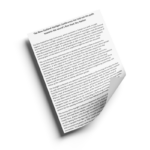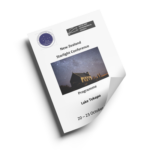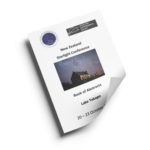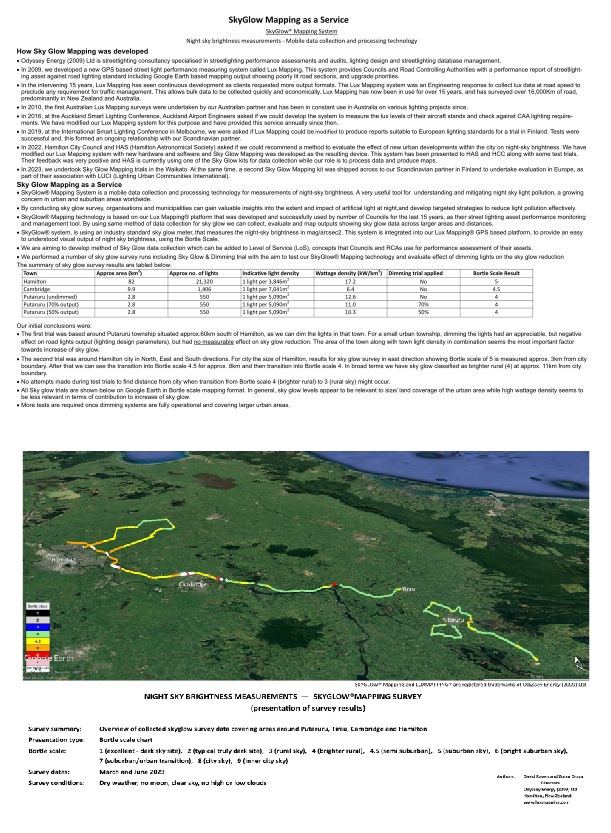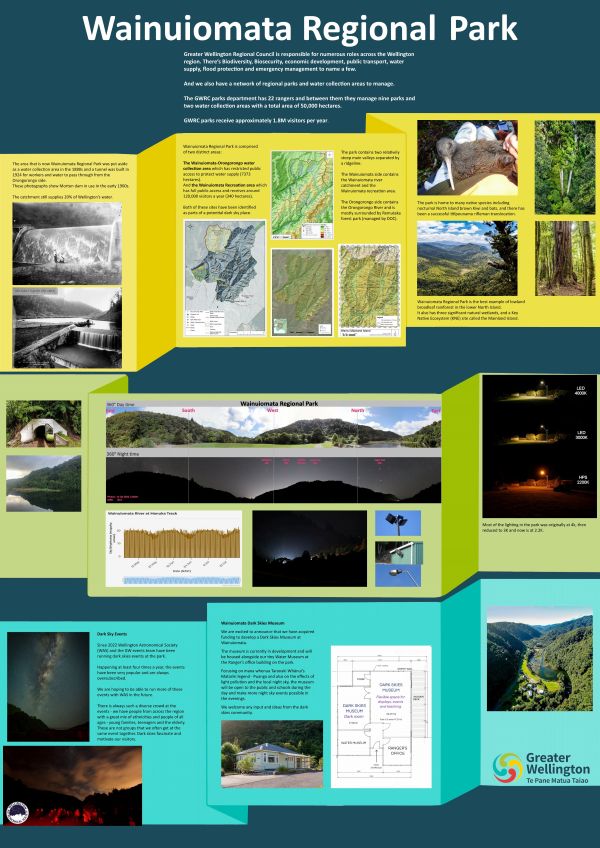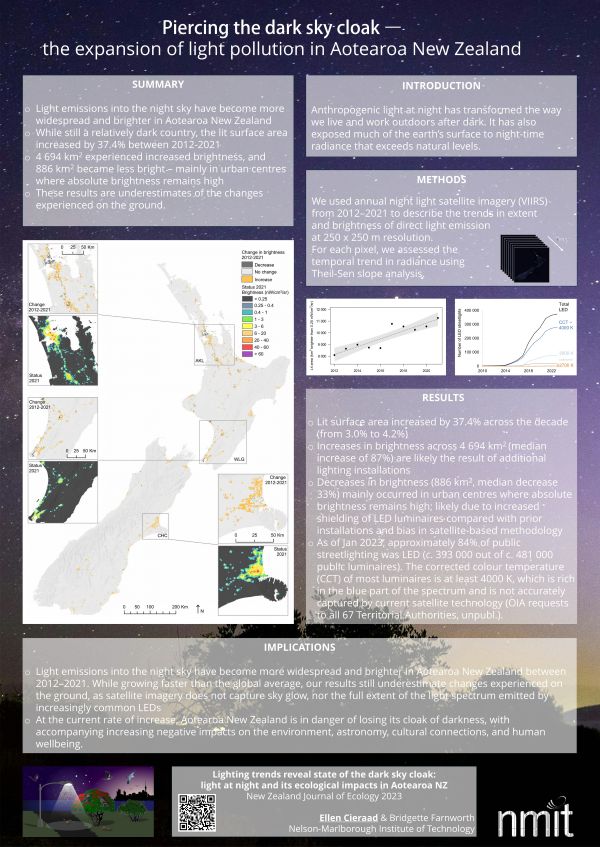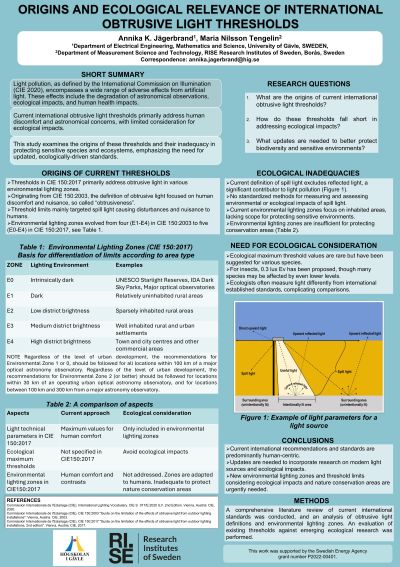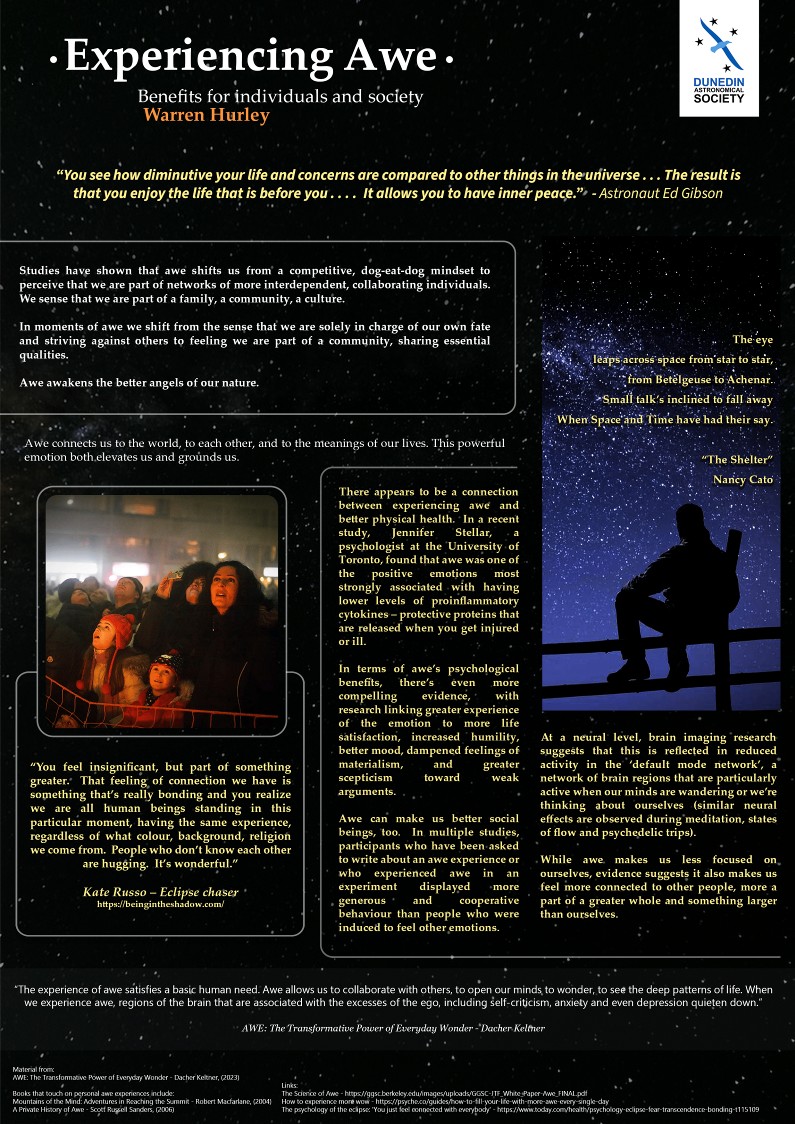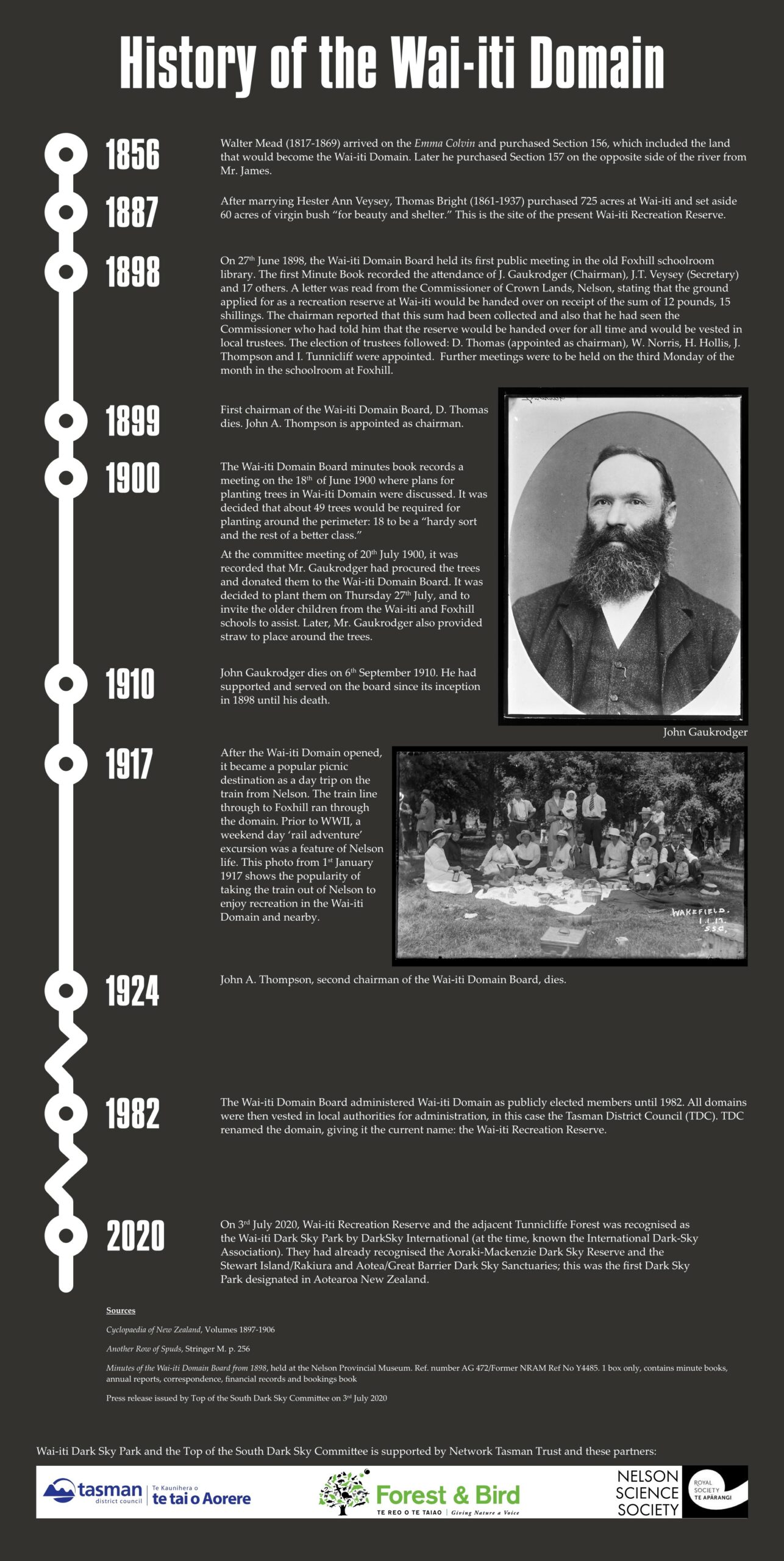New Zealand Starlight Conference - Towards a Dark Sky Nation
20-23 October 2024, Tekapo, New Zealand
 Posters
Posters
 Session One
Session One
Dark sky places and the global scene
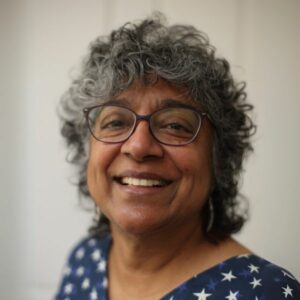
Chair: Nalayini Davies
Ruskin Hartley, Executive Director of DarkSky International, Tucson Arizona, USA
SPEAKER
Annika Jägerbrand, Gävle University, Gävle, Sweden
Ellen Cieraad, Nelson Marlborough Institute of Technology
David Welch, IUCN Dark Skies Advisory group, Ottawa, Canada
 Session Two
Session Two
Lighting technology and dark skies
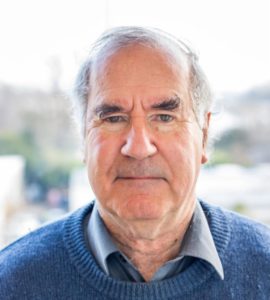
Chair: John Hearnshaw
Susan Mander, Massey University, Albany, Auckland and Auckland University of Technology
SPEAKER
Abhishek Wali, Connetics, Christchurch
Road Lighting Design: Strategies for Minimizing Light Pollution and Ensuring Safety
Andrea Sosa, CURE - Universidad de la República, Montevideo, Uruguay
co-authors: Florencia Reichmann, Andrés Olivera, Susana Colmegna, Santiago Roland, Macarena Risso, Keving Mendoza, Fabiana Guadalupe, Camila Gianotti, Valentina Pezano (Universidad de la República), Mariana Pérez (ONG Ambá), Fefo Bouvier (professional astrophotographer) & Pablo Chavarría (UTAP – Intendencia de Montevideo)
Brian Boyle, Winterstellar Charitable Trust, Gibbston Highway, Queenstown, NZ
Steve Butler, Chair of Aoraki Mackenzie International Dark Sky Reserve Board, chair of the Dark Skies group of the Royal Astronomical Society of New Zealand
 Session Three
Session Three
Light Pollution and Cultural Heritage
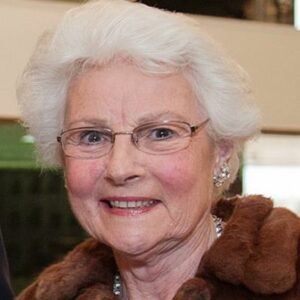
Chair: Margaret Austin
Joan Marie Galat, Author and freelance writer/editor, Edmonton, Alberta, Canada
SPEAKER
Peter Swanton, Australian National University, Canberra
Victoria Campbell, Dark Sky Project, Ngai Tahu Tourism, Lake Tekapo
Ladislaus Batinoluho, Dark-Sky Tanzania and Harrieth Mtae, the Open University of Tanzania, Dar es Salaam, Tanzania
Kyra Xavia, DarkSky International and Lightwise Guild, Dunedin, New Zealand
 Session Four
Session Four
Light Pollution Legislation
Light Pollution and the Environment
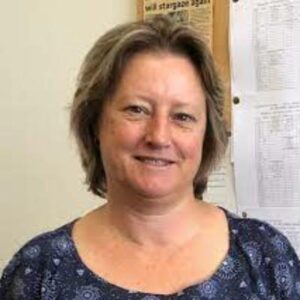
Chair: Karen Pollard
Yana Yakushina, University of Ghent, Ghent, Belgium
SPEAKER
Christopher Martin, Vela Science, Christchurch, NZ
John Hearnshaw, Aoraki Mackenzie International Dark Sky Reserve and University of Canterbury, Christchurch, NZ
Nicky McArthur, Kaikōura Dark Sky Trust, Kaikōura, NZ
Charlotte Harding: Wairarapa International Dark Sky Reserve, Carterton, NZ
 Session Five
Session Five
Light pollution as a global environmental issue (part 1)
Astrotourism (part 1)
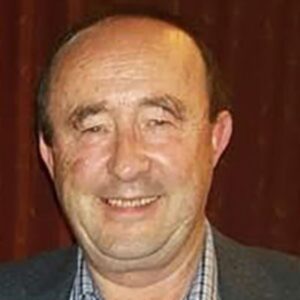
Chair: Steve Butler
Annika Jägerbrand, Gävle University, Gävle, Sweden
SPEAKER
Nalayini Davies, Royal Astronomical Society of NZ; DarkSky International
Laeticia Jacobs, Department of Tourism, Pretoria, South Africa
Shu An Hsu, Taiwan Ocean Wayfinding Association, Lake Tekapo, NZ
co-authors: Paichi Pat Shein (National Sun Yat-sen University, Taiwan) and Chien Wen Chen (National Taiwan Ocean University)
Axiou Lin, Taiwan Dark Sky Association, Taipei, Taiwan
 Session Six
Session Six
Light pollution as a global environmental issue (part 2)
Astrotourism and Dark Sky Places in New Zealand (part 2)

Chair: Nalayini Davies
Johan Eklöf, EnviroPlanning, Ulricehamn, near Gothenburg, Sweden
SPEAKER
Alasdair Burns, Twinkle Dark Sky Tours, Rakiura Stewart Island, NZ
Leslie van Gelder, Chair, Tāhuna Glenorchy Dark Sky Sanctuary, Glenorchy, Central Otago, NZ
co-author: Corrine Davis (Tāhuna Glenorchy Dark Sky Sanctuary)
The Hon Matt Doocey, National MP for Waimakariri, NZ Minister for Tourism and Hospitality
 Session Seven
Session Seven
Light pollution as a global environmental issue (part 3)
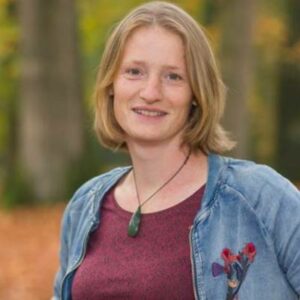
Chair: Ellen Cieraad
Bridgette Farnworth, Nelson Marlborough Institute of Technology, Nelson
co-author: Ellen Cieraad (NMIT)
SPEAKER
Elizabeth Atchoi, Institute of Marine Sciences - OKEANOS, University of the Azores, Portugal
co-authors: Mindaugas Mitkus (Institute of Biosciences, Life Sciences Center, Vilnius University, Vilnius, Lithuania), Joël Bried (Institute of Marine Sciences - OKEANOS, University of the Azores, Portugal), Manuela Juliano (Institute of Marine Sciences - OKEANOS, University of the Azores), Tânia Pipa (Sociedade para o estudo e proteção das aves, SPEA), Azucena Martin (Sociedade para o estudo e proteção das aves, SPEA), Airam Rodríguez (Departamento de Ecología Evolutiva, Museo Nacional de Ciencias Naturales, MNCN, CSIC, Madrid, Spain.
Cesar San Miguel, Australian Department of Climate Change, Energy, the Environment and Water, Canberra, Australia
co-authors: Karen Arthur (DCCEEW, Canberra), Narelle Montgomery (DCCEEW) and Kelly Pendoley (Australasian Dark Sky Alliance, Pendoley Environmental Pty Ltd, Perth, WA)
Robert Dick, IUCN Dark Skies Advisory Group, Ottawa, Canada
co-author: David Welch, IUCN Dark Skies Advisory Group, Ottawa, Canada
Ping Lei, Melbourne, Australia
 Session Eight
Session Eight
Astrophotography and astroaesthetics
Astrotourism (part 3)

Chair: John Hearnshaw
Steve Chadwick, Massey University, Palmerston North, NZ
SPEAKER
Amie Young, Destination Development Manager, Great South, Invercargill, NZ
Hidehiko Agata, National Astronomical Observatory of Japan, Mitaka, Tokyo, Japan
Louise Beer, writer, curator and artist, London and Margate, UK
 Session Nine
Session Nine
Light pollution and human health (part 1)
Astrotourism (part 4)

Chair: Ellen Cieraad
Mario Motta, former trustee American Medical Association, Boston, Mass., USA
SPEAKER
Bryan Boulanger, Ohio Northern University, Ada, Ohio, USA
Lin Mei, Shenzhen Astronomical Observatory, Shenzhen, China
Mohammad Saleh Timar, editor of Nojum Magazine, Tehran, Iran
 Session Ten
Session Ten
Light pollution, human health (part 2)
Astrotourism (part 5)

Chair: Karen Pollard
Philippa Gander, Massey University, Palmerston North, New Zealand
SPEAKER
Alexander Tups,
Centre for Neuroendocrinology and Brain Health Research Centre, Department of Physiology, School of Biomedical Sciences, University of Otago, Dunedin, NZ
Luca Devescovi, Akaroa Stargazing, Akaroa, Banks Peninsula, New Zealand
Kaye Paardekooper, Mt Cook Lakeside Retreat, Lake Pukaki, South Canterbury, NZ
Aryush Aravind, high school student from Irvine, California, USA
 Session Eleven
Session Eleven
Satellite constellations and astronomy
Dark sky places of the
world

Chair: Steve Butler
Connie Walker, NOIRLab and International Astron. Union, Center for Protection of Dark & Quiet Skies (CPS), Tucson, Arizona, USA
SPEAKER
Michele Bannister, University of Canterbury, Christchurch, NZ
Karen Pollard, University of Canterbury, Christchurch, New Zealand
Benyan Jiang, Guangzhou University, China
co-authors: Shuyi Jian (Guangzhou University), Jianchuan Zheng (Shenzhen Astronomical Observatory) and Jianjun Li (Guangzhou University)
Gareth Davies, DarkSky International and Dark Sky Network New Zealand, Auckland, NZ
 Session Twelve -
Astrotourism (part 6)
Session Twelve -
Astrotourism (part 6)
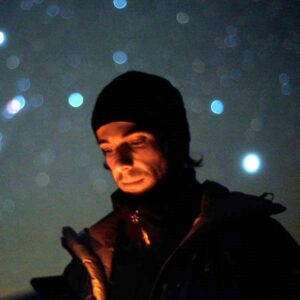
Chair: Adrien Vilquin Barrajon
Carol Redford, Astrotourism WA, Perth, Western Australia
SPEAKER
Darius Singh, Blue Phoenix Group (Fiji) Pte Ltd, Dreketi, Vanua Levu, Fiji
Koki Sawada, Wakayama University, Wakayama, Japan
co-authors: Tatsuki Yonezawa (Kimino Town Misato Astronomical Observatory) and Masami Okyudo (Nara Prefectural University)
